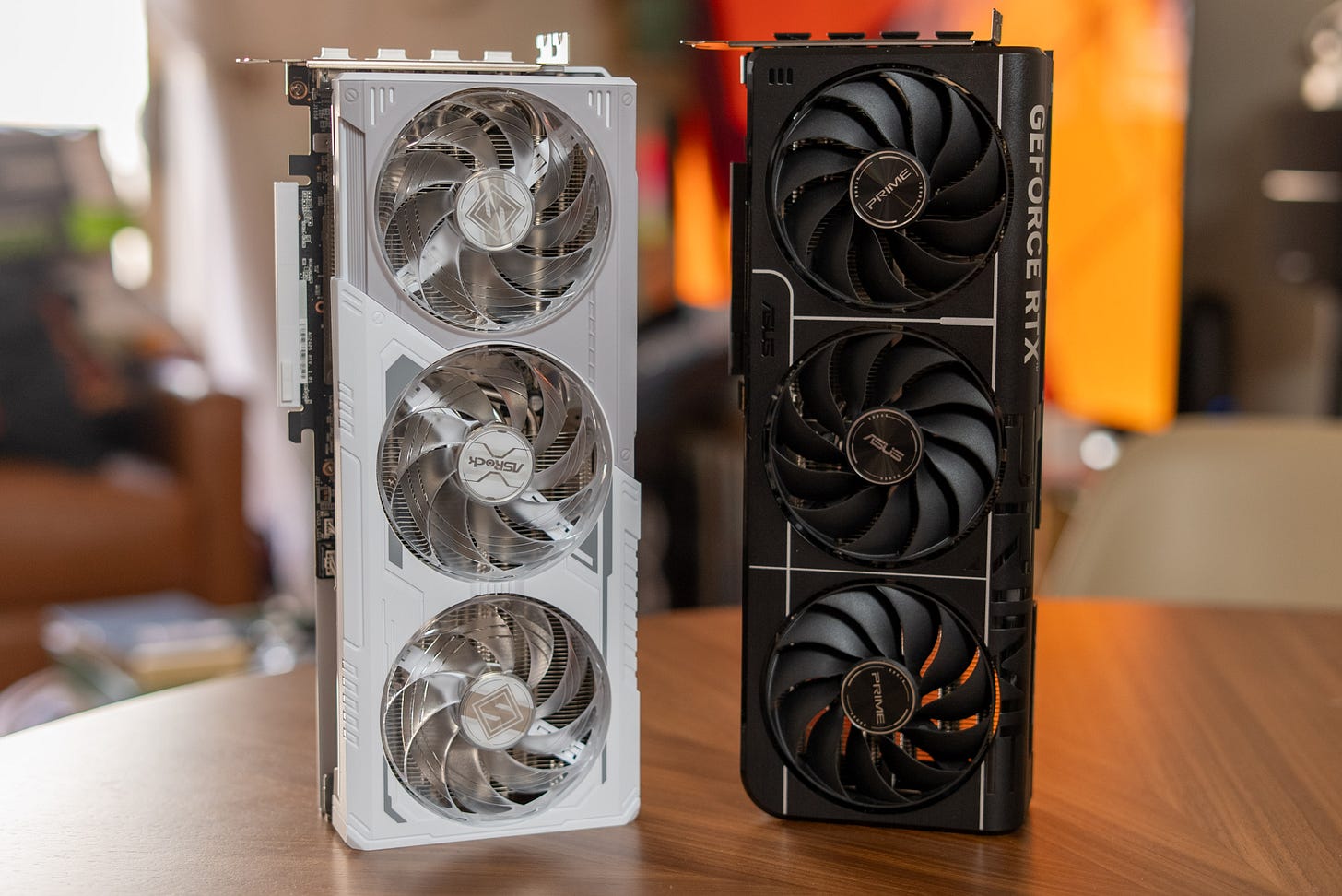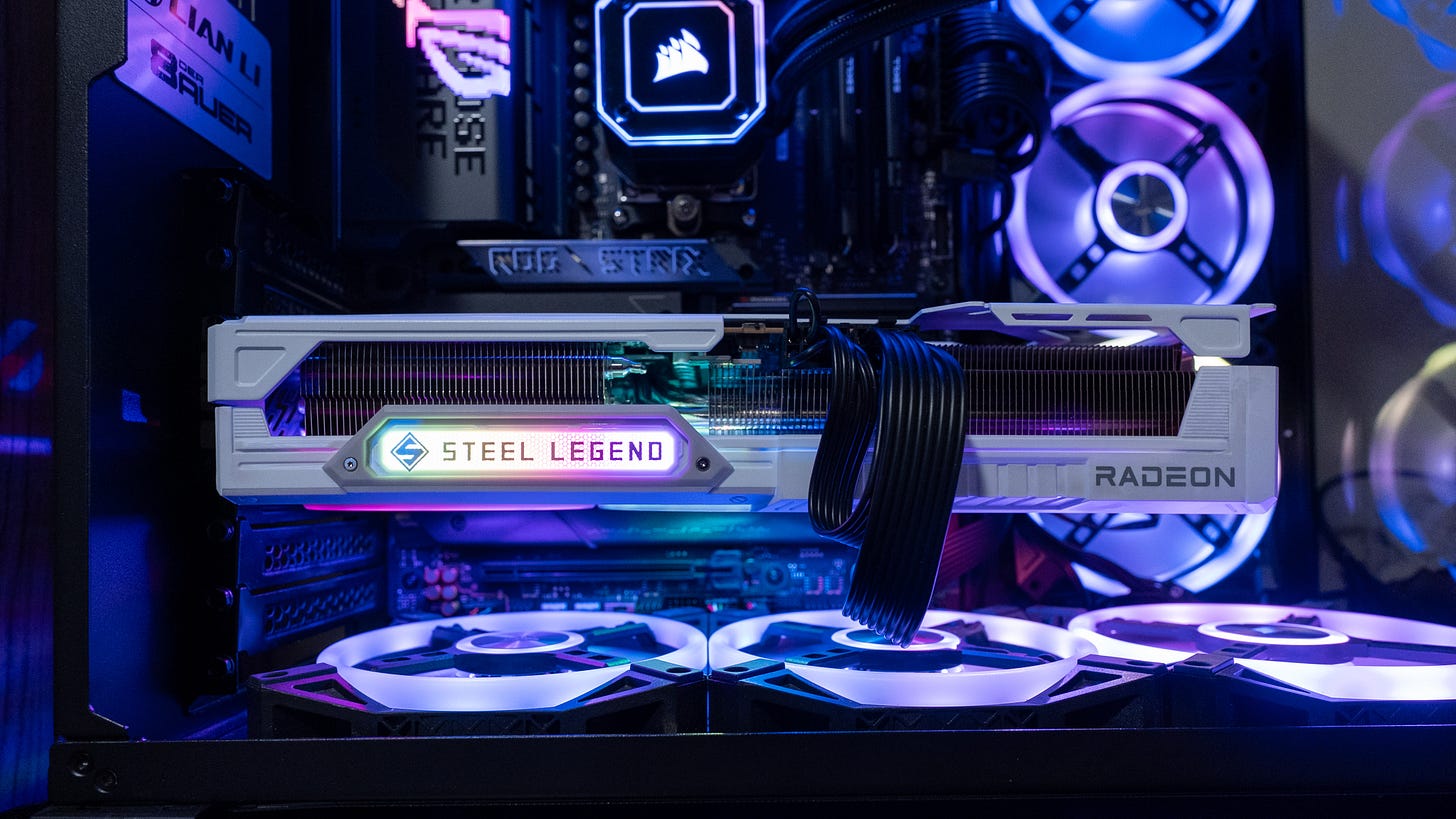AMD Radeon RX 9070 XT review: the best AMD graphics card in years
More powerful with huge leaps in AI upscaling and ray tracing
🏆 Review score: 4.5 out of 5
🏅 Editor’s Choice Award
Pros
✅ 🎮 Delivers 60+ fps gaming at 4K ultra settings
✅ 🤖 Big AI upscaling and ray tracing improvements
✅ 💪 Plenty of pure rasterization power
✅ ☀️ Greatly improved ray tracing performance
✅ 📺 FSR 4 delivers cleaner AI upscaling
✅ 🔌 As, if not more, power efficient than last generation
Cons
❌ 🌱 Small library of FSR 4-supported games is slowly growing
❌ 🤦🏻♂️ Convoluted process to switch on FSR 4
❌ 🤨 Why is FSR 4 turned off by default!?
❌ 🏷️ Trump tariffs and market increase MSRP to $699 and up
The Shortcut Review
Hallelujah! Your prayers for a powerful ray tracing and AI upscaling AMD graphics card have finally been answered with the advent of the Radeon RX 9070 XT. This GPU truly marks AMD’s triumphant return to mainstream PC gaming with performance that occasionally punches up to the Nvidia RTX 5070 Ti. Though it doesn’t thoroughly trounce Nvidia’s high-end card, it delivers surprisingly competitive performance for $600 MSRP vs Nvidia’s $750 MSRP GPU. Also, for just $50 more than the AMD Radeon RX 9070, you also get more stable 60+ fps gaming at 4K ultra settings.
The RX 9070 XT finally lets me tick on all the ray tracing I want while gaming with an AMD graphics card. FSR 4, meanwhile, introduces AMD’s first AI-based upscaler that eliminates ghosting and artifacts, though at the cost of a lower frame rate in most games. Unfortunately, AMD hasn’t made it a seamless process to turn on FSR 4, and only a few dozen games are supported as of this writing.
Full Review
💵 Pricing sweet spot. The AMD Radeon RX 9070 XT’s performance places it somewhere between the Nvidia RTX 5070 Ti and RTX 5070. It never quite matches or exceeds the FPS you can get from the RTX 5070 Ti, but it’s also never completely left in Nvidia’s dust. If you’re gaming at QHD or Full HD, the $599 RX 9070 XT offers quite a bargain for 60 to 120fps gaming at Ultra settings compared to the $749 Nvidia RTX 5070 Ti.
💪 Raw power. When it comes to pure raw graphical power, the AMD Radeon RX 9070 XT pulls ahead of the Nvidia RTX 5070. This is evidenced by the higher synthetic 3DMark scores and its higher fps in Cyberpunk 2077 without any upscaling aid. This isn’t surprising when the 9070 XT’s GPU die is fitted with more performant compute units and more ROPs (raster operations pipeline or render output unit). The 9070 XT’s underlying Navi 48 GPU is also comprised of all 4nm cores, as opposed to the preceding Navi 32’s mix of 5nm and 6nm components. This smaller, monolithic architecture has proven to deliver higher performance.

Faster than an OC AMD Radeon RX 9070. You may have noticed that the RX 9070 XT is only 1-3fps faster than the RX 9070 we tested, but that’s because AMD actually sent us an OC version of its junior GPU. The ASRock Radeon RX 9070 XT is meant to sell for $669 MSRP, compared to the $599 MSRP RX standard 9070 we tested. That makes the RX 9070 XT even more impressive, considering it’s meant to actually come at only a $50 premium over the 9070. If you have the extra cash – and prices aren’t dramatically inflated – get the 9070 XT over the standard RX 9070.
🦘 Huge architectural leap. RNDA 4 has brought AMD’s architectural leap in years. AMD claims it has increased ray tracing performance by 100%, and it shows when I can run GTA V Enhanced Edition and Red Dead Redemption 2 with maximum ray tracing and get over a steady 60fps. Moreover, RDNA 4 introduces AMD’s first-ever machine learning-based AI upscaler in FSR 4 to compete with DLSS 4.
🔦 Trace those rays. Ray tracing on AMD graphics cards has always lagged since Nvidia kicked off its RTX GPUs to lead the market. However, the RX 9070 XT is the first card I can reliably use to tick on all the ray tracing effects. Assassin’s Creed: Shadows and Cyberpunk 2077 easily ran at over 4K 60 even with maxed out ray tracing enabled. RDNA 4 has effectively doubled the ray box intersection rates for triangles and boxes to make it a much more suitable card for ray-traced shadows, reflections, and even global illumination.
🤖 AI brains. FSR 4 is AMD’s long-overdue answer to Nvidia DLSS AI upscaling solution. While the temporal-based upscaling FidelityFX Super Resolution employed has been efficient at boosting frame rates, it always came with more ghosting and fuzziness compared to DLSS. FSR 4 fixes that by using AI accelerators, 128 of them in the 9070 XT, to analyze frames and game engine data to upscale games to a higher resolution.
⚖️ More or fewer frames? Unfortunately, FSR 4’s AI upscaling doesn’t translate directly to more frames per second across all games. In Space Marine II, I saw a 6fps increase going from FSR 3.1 to FPS 4, while Call of Duty: Black Ops 6 actually slowed down by 5fps with the newer AI upscaler. The AI model of FSR 4 is simply a more taxing workload that focuses on removing artifacts and ghosting, so the overall image is better. Higher fps is more of a nicety you may get with certain games, but more often, I saw the frame rate go down with FSR 4 turned on.
⏻ Don’t forget to turn on FSR 4. Another rub about FSR 4 is that you have to turn it on manually. Rather than switching between FSR 3.1 and 4 in-game menus, you have to dive into AMD’s Adrenalin software to have it override FSR 3.1. It’s not really intuitive, nor does AMD’s software call it out. This FSR 4 override also only works on games that support it, which you’ll look up yourself, as there’s no indicator to show games are actually running the new AI upscaler. Some new RX 9070 users may even just start using their new GPU while entirely missing out on one of its crucial new features. So far, Call of Duty: Black Ops 6 is the only game that has an in-menu toggle for FSR 4.
🌱 Growing FSR 4 support. FSR 4 has a small but growing library of supported games. At launch, there were only 30 FSR4-supported games with big hitters like Spider-Man 2, The Last of Us Part 1, Horizon Forbidden West, and Marvel Rivals. AMD recently added eight more supported games, including Ghost of Tsushima, Frostpunk 2, and The Finals. However, there’s still a lot more to add, like AC Shadows and Kingdom Come: Deliverance II. I personally would like to see 100% of FSR 3.1 games being automatically ported to FSR 4, but that’s only wishful thinking for a very complicated and technical process.
🔌 Power efficient. The AMD Radeon RX 9070 XT has one of the smallest generational TDP bumps, which pushes its power needs to 304W compared to the previous 300W RX 7900 XT. In my testing, the RX 9070 XT peaked at 306W, and I saw its average power draw float around 197W. That’s not bad compared to the considerable jump in power usage seen on Nvidia’s RTX 50-series cards.
Should you buy the AMD Radeon RX 9070 XT?
Yes, if…
✅ You want a graphics card that consistently delivers 60+ fps gaming at 4K ultra
✅ You want a GPU that’s more powerful than the Nvidia RTX 5070
✅ You need more pure rasterization power for gaming
No, if…
❌ Most of the games you play don’t support FSR 4 (get the Nvidia RTX 5070 Ti instead)
❌ You don’t want to spend over $599 MSRP (wait for a sale or for Trump to lower tariffs)
Kevin Lee is The Shortcut’s Creative Director. Follow him on Twitter @baggingspam.







